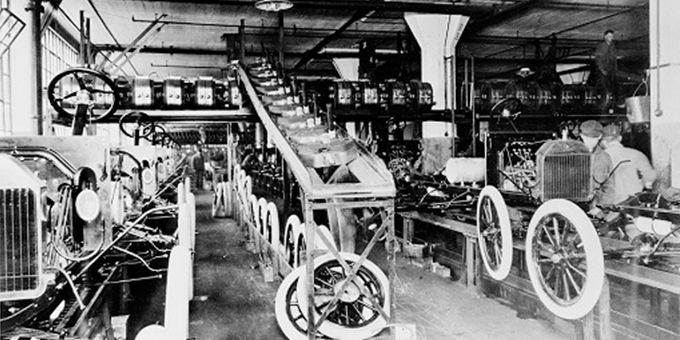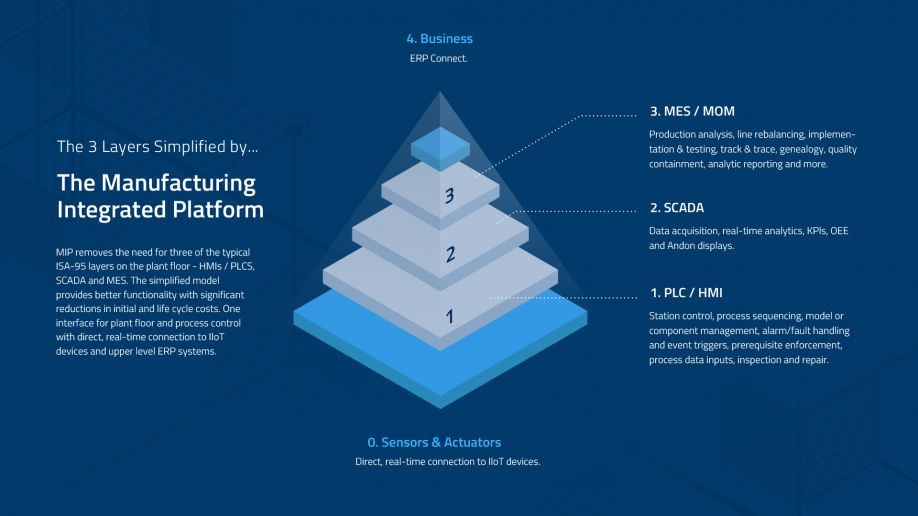Why the Manufacturing Integrated Platform (MIP) represents the biggest leap forward since Henry Ford
 Integration Innovation
Integration Innovation

Dan McKiernan, President | eFlex Systems
From the earliest days of modern-style manufacturing—all the way back to the historic and now iconic assembly lines of Henry Ford—it’s been clear that manufacturing innovators have been keenly focused on finding new ways to control and refine the process of production.
Ford exerted that control by limiting available customization options (famously, for a long time the Model T was only available in black). He streamlined the production process by breaking the assembly process of the Model T into 84 discrete steps, using specialized training and input from motion-study experts to maximize efficiency, and by designing and building machines that could create parts with a speed and uniformity that exceeded the capacity of even the most skilled craftsmen.
Much of the century since Ford’s breakthrough innovations has been filled with advancements that are essentially just more sophisticated attempts to continue to meet those same core mandates of specialization, precision and automation. Manufacturers have turned to precision components and interchangeable parts; leveraged facilities and operators that have become increasingly specialized; benefitted from powerful new automation advances; and embraced just-in-time and lean manufacturing principles to boost efficiency.
But with sophistication comes complexity. Because, for all of the power it affords, the different layers of the modern manufacturing stack have introduced formidable new technical and logistical challenges. Essentially, the industry has innovated itself into a corner.
But as a handful of early adopters are already discovering, the way information flows through the stack, across the factory floor, and throughout the enterprise is about to be transformed in an extraordinary and game-changing manner.
The technologies behind this breakthrough include things like the IIoT, machine learning, big data, and cloud-based systems, the pillars of a wave of innovation collectively referred to as Industry 4.0. While innovators and manufacturing solutions providers are using these tools in interesting and exciting ways, the vast majority remain focused on their own specialized arena: one or perhaps two layers of the stack.
Today, however, the industry finds itself on the cusp of something much more ambitious: the Manufacturing Integrated Platform (MIP), a single, truly holistic manufacturing solution. A MIP is a versatile, scalable platform, a comprehensive manufacturing solution designed to leverage the power of Industry 4.0 technologies across a range of different production or assembly environments.

The right MIP delivers a transformative and cost-effective solution for plant floor control, visibility and error-proofing, making it easier than ever before to configure and manage manufacturing environments, standardize work instructions and process control, and monitor and enforce quality standards.
A high-end MIP solution essentially replaces almost all of the layers of the traditional automation stack with robust functionality that all work together in one environment. A MIP can deliver the automation and direct control capabilities of HMIs and PLCs; the data collection, real-time analysis and supervisory functionality of SCADA software; and the monitoring and control functions of MES systems. By streamlining and reducing independent layers of traditional solutions, the cost and complexity of coordinating and conveying information from one layer to the next is reduced or eliminated.
Streamlined simplicity
MIPs promise previously unthinkable levels of power, efficiency, utility and flexibility and control. But what truly sets a leading MIP solution apart is its simplicity. Instead of adding new complexity atop layers of legacy systems and infrastructure, MIP functionality streamlines and simplifies. By changing the way information is delivered and utilized, MIPs simultaneously provide more autonomy on the part of individual operators while also giving plant managers more control and transparency across the production environment.
The MIP revolution deviates from the industry’s well-established pattern of iterative innovation and introduces something entirely new: a fundamental reimagining of how plant floor operate. The promise isn’t new bells and whistles for existing platforms, but a solution that replaces them entirely. In other words: the technical architecture of manufacturing environments—or really any process-dependent industry—hasn’t just been improved, it’s been replaced. The Gordian knot of automation complexity has been severed with a single inspired stroke.
A better sandwich
To appreciate the extent to which MIP solutions have the potential to reshape the manufacturing automation landscape, it’s important to recognize how the contours of that landscape became so uneven in the first place.
As the manufacturing industry has evolved, the technical complexity of the automation stack became increasingly formidable, prompting the International Society of Automation to take action and outline a single ISA-95 international standard for all global manufacturers. ISA-95 was designed to ensure clarity and continuity for everything from terminology, to informational and operational models.
Despite these efforts, communications and coordination challenges have remained among the most difficult obstacles to overcome. Ironically, as new innovations have been introduced at any one layer of the stack, coordination and communication across the stack often suffers. Picture the manufacturing automation stack like a multi-layered sandwich. Over the years, new ingredients have been added, bringing new tastes and flavors, but both the structural and culinary integrity of the sandwich begins to suffer. Modern manufacturers find themselves with a towering sandwich that might look good on the plate, but is awfully tough to handle—and could fall apart at any moment.
What is needed isn’t another new ingredient—it’s a whole new recipe.
Breakthroughs and benefits
The implications of the MIP revolution are significant and potentially profound. Because it takes a substantial amount of engineering and expense to coordinate and convey information from each level of the stack to the next, a robust all-in-one MIP solution’s ability to replace those layers and control the whole plant floor directly through to the ERP represents a radical and truly transformative innovation.
Replacing the aging technology of PLCs alone delivers a huge leap forward in efficiency. And because the best MIPs are web-based solutions, changing a single webpage instead of updating each individual HMI. Some MIPs feature cutting-edge digital work instruction platforms with a user-friendly interface allowing operators to access the system through any connected mobile device and create, edit and assign work instructions within the application itself. As a result, time-consuming and complex process changes can be performed in a matter of moments. With the right MIP, you also have the built-in opportunity to add a whole host of new integrated tools and features, from augmented reality solutions, torque guns to high-speed cameras with sophisticated image capture functionality.
That connectivity facilitates the collection of extraordinarily detailed and granular process data and cycle times, delivering information that can be evaluated and acted upon in real time. Plant managers can ensure that parameters are being met, that obstacles or inefficiencies are quickly addressed, and that products and processes are done right—each and every time.
An integrated future
Versatility and visibility. Streamlined simplicity. Unparalleled utility. Precise process control and information-gathering—conveyed through customizable real-time dashboards and powerful integrated reporting functionality. All of it easier, more efficient, and less complicated than any other systems in use today. In an industry where more functionality has often meant more complexity, the MIP revolution offers a dramatic and transformative paradigm shift and a new way forward for manufacturers everywhere.
Even beyond the game-changing utility, power and sophistication a high-end MIP solution can deliver, there are practical considerations that make them an attractive option for many manufacturers. A true all-in-one solution means integration issues between different systems and software virtually disappear, and manufacturers can deal with one solution provider instead of a whole host of separate vendors.
While many operators in this space continue to focus on their own specialized niches, and the speed with which the industry will gravitate toward MIP solutions remains to be seen, there seems to be little doubt that the extraordinary potential of this disruptive new category of manufacturing solutions will soon make MIPs not just a standard setter, but the industry standard.
The content & opinions in this article are the author’s and do not necessarily represent the views of ManufacturingTomorrow
Comments (0)
This post does not have any comments. Be the first to leave a comment below.
Featured Product

